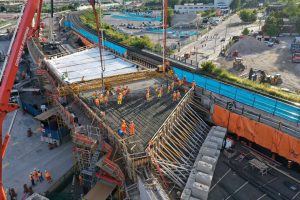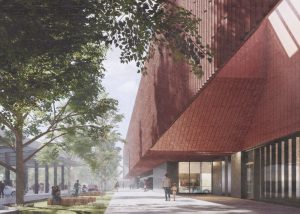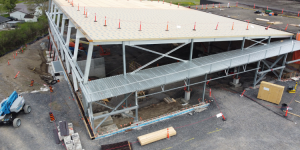PCL Constructors Canada Inc. is on track to achieve substantial completion early next February on a 40-storey office tower in downtown Toronto.
The construction giant is acting as construction manager on the LEED Platinum building, located at 100 Adelaide St. W. between Bay and York streets. Designed by New York architects Kohn Pedersen Fox and assisted locally by Toronto’s WZMH Architects, the 1.2-million-square-foot tower is being constructed for Oxford Properties Group. It will be known as the Ernst & Young Tower after its lead tenant.
Key consultants include Stephenson Engineering Ltd. (structural), Smith + Andersen (mechanical), MMM Group (electrical) and Goldsmith Borgal & Co. Ltd. (heritage).
At the ground level, the project retains the facade of the historic Concourse Building including mosaics designed by Group of Seven artist J.E.H. MacDonald.
A modern new entrance and public space will serve to bridge the old with the new.
The tower will be hooked up to Enwave’s deep lake water cooling system.
PCL construction manager Reynder Van Der Meulen said the project’s LEED Platinum status hasn’t posed any particular challenges from a construction perspective.
"LEED certainly changes the make-up of your building," he said. "But really, the challenges with this building were more to do with its location on a tight site, keeping adjacent buildings operational — and its unique structure."
Green features include a high-performance building envelope.
PCL was officially appointed construction manager in the spring of 2013. But the construction company had been working with Oxford Properties since fall 2012.
"We were on board early to discuss constructability issues, but more importantly from Oxford’s perspective, to ensure that what was being designed remained within the project budget," Van Der Meulen said.
As part of a pre-planning exercise, PCL drafted a detailed master schedule outlining various milestone dates for completing designated activities — everything from erection of tower crane number one and a start on curtainwall installation to completion of the concrete structure.
"It was just amazing to see that even though this was planned in 2012, we met the schedule right down to the day on most of our milestones," Van Der Meulen said.
"That really is a testament to the people who did the advance planning."
Key subcontractors provided input as well.
In advance of starting construction of the tower itself, certain early works were undertaken which included demolition of the Concourse Building as well as a parkade on Sheppard Street.
Along the way an adjacent steakhouse, which remained open for business, was renovated. The restaurant had to be made "a little narrower and a little taller" to accommodate construction of the tower, Van Der Meulen said
The new tower will be part of the 2.4-million-square-foot Richmond Adelaide Centre.
Van Der Meulen said one of the key construction challenges involved maintaining access to a central loading dock that services the complex. Multiple options to maintain access were reviewed before a decision was made to construct a temporary bridge.
"We had to keep the old loading dock functioning throughout all the demolition and excavation work," he said. "Trucks come and go from that loading dock seven days a week.
"Later on, this required construction of a new loading dock and getting it fully operational before we could take the old dock out of service. This made for a fairly complex process."
The tower’s "unique" structure posed certain challenges as well when it came to construction, Van Der Meulen said. No two floor plates are exactly alike.
"The top section of the building has a complicated structural steel frame that is purposely absent of plumb lines," he said. "This gives the building a great esthetic but it does create some added complexity as to how things are fabricated and constructed."
Rather than a typical flat roof, the top of the building will feature a large geometric "lantern" space that can be illuminated at night to accent the architectural form of the steel and glass structure.
Five floors near the building’s top have already been turned over to Oxford Properties for tenant fit-out. Upper floors will be occupied by Ernst &Young.
"That’s one of the other challenges," Van Der Meulen said. "We are turning over the top of the building before the bottom."
Permanent cranes will be put in place on the rooftop for building maintenance purposes — such as cleaning the tower’s exterior glass.
"These are a common sight in Manhattan," Van Der Meulen said.
Construction of the tower has involved a small army of subcontractors. Major subs include: Hardrock/Structform Joint Venture (concrete structure); Walters Inc. (structural steel); Oldcastle Building Envelope (curtainwall); Clifford Restoration (heritage restoration) and Plan Group (mechanical/electrical).
Prior to achieving substantial completion, mechanical and electrical equipment must be installed, a job which Van Der Meulen said will entail "thousands of hours" of work.
As well, the tower’s building systems must be commissioned and any deficiencies corrected.
"When completed, I think this is going to be somewhat of an iconic structure in the downtown core," said Van Der Meulen, who joined PCL in 1995.










Recent Comments
comments for this post are closed